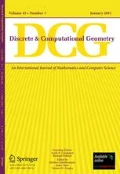Abstract
A notion of open rank, related with generic power sum decompositions of forms, has recently been introduced in the literature. The main result here is that the maximum open rank for plane quartics is eight. In particular, this gives the first example of n, d, such that the maximum open rank for degree d forms that essentially depend on n variables is strictly greater than the maximum rank. On one hand, the result allows to improve the previously known bounds on open rank, but on the other hand indicates that such bounds are likely quite relaxed. Nevertheless, some of the preparatory results are of independent interest, and still may provide useful information in connection with the problem of finding the maximum rank for the set of all forms of given degree and number of variables. For instance, we get that every ternary form of degree \(d\ge 3\) can be annihilated by the product of \(d-1\) pairwise independent linear forms.
Similar content being viewed by others
Notes
Sometimes the term “Waring decomposition” has been used to indicate simply a power sum decomposition, without the minimality hypothesis. We also mention that the symmetric rank is sometimes called polar rank: see [25].
We say that a zero-dimensional scheme is curvilinear if it can be embedded in some smooth curve.
References
Alexander, J., Hirschowitz, A.: Polynomial interpolation in several variables. J. Algebr. Geom. 4(2), 201–222 (1995)
Ballico, E., Bernardi, A.: Decomposition of homogeneous polynomials with low rank. Math. Z. 271(3–4), 1141–1149 (2012). doi:10.1007/s00209-011-0907-6
Ballico, E., Bernardi, A.: Stratification of the fourth secant variety of Veronese varieties via the symmetric rank. Adv. Pure Appl. Math. 4(2), 215–250 (2013). doi:10.1515/apam-2013-0015
Bernardi, A., Gimigliano, A., Idà, M.: Computing symmetric rank for symmetric tensors. J. Symb. Comput. 46(1), 34–53 (2011). doi:10.1016/j.jsc.2010.08.001
Białynicki-Birula, A., Schinzel, A.: Representations of multivariate polynomials by sums of univariate polynomials in linear forms. Colloq. Math. 112(2), 201–233 (2008). doi:10.4064/cm112-2-2
Białynicki-Birula, A., Schinzel, A.: Corrigendum to “Representatons of multivariate polynomials by sums of univariate polynomials in linear forms” (Colloq. Math. 112 (2008), 201–233). Colloq. Math. 125(1), 139 (2011). doi:10.4064/cm125-1-10
Blekherman, G., Teitler, Z.: On maximum, typical and generic ranks. Math. Ann. 362(3–4), 1021–1031 (2015). doi:10.1007/s00208-014-1150-3
Buczyńska, W., Buczyński, J.: Secant varieties to high degree Veronese reembeddings, catalecticant matrices and smoothable Gorenstein schemes. J. Algebr. Geom. 23(1), 63–90 (2014). doi:10.1090/S1056-3911-2013-00595-0
Buczyński, J., Teitler, Z.: Some examples of forms of high rank. Collect. Math. 67(3), 431–441 (2016). doi:10.1007/s13348-015-0152-0
Carlini, E., Catalisano, M.V., Geramita, A.V.: The solution to the Waring problem for monomials and the sum of coprime monomials. J. Algebra 370, 5–14 (2012). doi:10.1016/j.jalgebra.2012.07.028
Comas, G., Seiguer, M.: On the rank of a binary form. Found. Comput. Math. 11(1), 65–78 (2011). doi:10.1007/s10208-010-9077-x
De Paris, A.: A proof that the maximum rank for ternary quartics is seven. Matematiche (Catania) 70(2), 3–18 (2015). doi:10.4418/2015.70.2.1
De Paris, A.: Every ternary quintic is a sum of ten fifth powers. Int. J. Algebra Comput. 25(4), 607–631 (2015). doi:10.1142/S0218196715500125
De Paris, A.: The asymptotic leading term for maximum rank of ternary forms of a given degree. Linear Algebra Appl. 500, 15–29 (2016). doi:10.1016/j.laa.2016.03.012
Derksen, H., Teitler, Z.: Lower bound for ranks of invariant forms. J. Pure Appl. Algebra 219(12), 5429–5441 (2015). doi:10.1016/j.jpaa.2015.05.025
Ellia, Ph., Peskine, Ch.: Groupes de points de \({{\mathbb{P}}}^2\): caractère et position uniforme. In: Sommese, A.J., Biancofiore, A., Livorni, E.L. (eds.) Algebraic Geometry. Lecture Notes in Mathematics, vol. 1417, pp. 111–116. Springer, Berlin (1990)
Fulton, W.: Intersection Theory. Ergebnisse der Mathematik und ihrer Grenzgebiete. 3. Folge. A, 2nd edn. Springer, Berlin (1998)
Geramita, A.V.: Exposé I A: Inverse systems of fat points: Waring’s problem, secant varieties of Veronese varieties and parameter spaces for Gorenstein ideals. In: The Curves Seminar at Queen’s, vol. X. Queen’s Papers in Pure and Applied Mathematics, vol. 102, pp. 2–114. Queen’s University, Kingston (1996)
Hartshorne, R.: Algebraic Geometry. Graduate Texts in Mathematics, vol. 52. Springer, New York (1977)
Iarrobino, A., Kanev, V.: Power Sums, Gorenstein Algebras, and Determinantal Loci. With an Appendix ‘The Gotzmann Theorems and the Hilbert Scheme’ by Anthony Larrobino and Steven L. Kleiman. Lecture Notes in Mathematics. Springer, Berlin (1999). doi:10.1007/BFb0093426
Jelisiejew, J.: An upper bound for the Waring rank of a form. Arch. Math. 102(4), 329–336 (2014). doi:10.1007/s00013-014-0632-6
Kleppe, J.: Representing a Homogenous Polynomial as a Sum of Powers of Linear Forms. Thesis for the degree of Candidatum Scientiarum, University of Oslo, Oslo. http://folk.uio.no/johannkl/kleppe-master.pdf (1999). Accessed 9 Jan 2017
Landsberg, J.M.: Tensors: Geometry and Applications. Graduate Studies in Mathematics, vol. 128. American Mathematical Society, Providence (2012)
Landsberg, J.M., Teitler, Z.: On the ranks and border ranks of symmetric tensors. Found. Comput. Math. 10(3), 339–366 (2010). doi:10.1007/s10208-009-9055-3
Pate, T.H.: Lower bounds for polar and tensor ranks. Linear Multilinear Algebra 21(3), 277–287 (1987). doi:10.1080/03081088708817802
Author information
Authors and Affiliations
Corresponding author
Additional information
Editor in Charge: Kenneth Clarkson
Rights and permissions
About this article
Cite this article
Ballico, E., De Paris, A. Generic Power Sum Decompositions and Bounds for the Waring Rank. Discrete Comput Geom 57, 896–914 (2017). https://doi.org/10.1007/s00454-017-9886-7
Received:
Revised:
Accepted:
Published:
Issue Date:
DOI: https://doi.org/10.1007/s00454-017-9886-7


